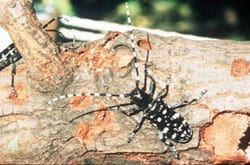Anoplophora glabripennis
A.L.B. are 3/4 to 1 1/4 inches (20 – 32 mm) long and are glossy jet black they are very smooth with up to 20 distinct white spots on the back.
There host include Maple species; Horsechestnut, Elms, Birches, Willows, Boxelder and Poplars but there may be more.
They are native to China and Korea and and have been introduced into the U.S. into MASSACHUSETTS and NEW YORK and NEW JERSEY through wood packing materials.
When the eggs hatch, small white larvae bore their way through the bark into the tree feeding on the sensitive vascular layer beneath. The larvae continue to feed deeper into the tree’s heartwood forming tunnels, or galleries, in the trunk or branches.
This damage eventually kills the tree if the infestation is severe enough.
When the larva matures over the course of a year, it forms a pupa near the surface under the bark. From the pupa, an adult beetle emerges chewing its way out of the tree forming characteristic round holes approximately 3/8 ths of an inch in diameter. Many of these holes will appear on a heavily infested tree sometimes with sawdust associated and sap oozing from the holes
ALB have one generation per year. Adult beetles are usually present from July to October, but can be found later in the fall if temperatures are warm. Adults usually stay on the trees from which they emerged or they may disperse short distances to a new host to feed and reproduce. Each female is capable of laying up to 160 eggs. The eggs hatch in 10-15 days and the larvae tunnel under the bark and into the wood where they eventually pupate. The adults emerge from pupation sites by boring a tunnel in the wood and creating a round exit hole in the tree.


